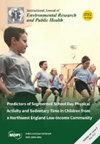脑瘫儿童行动能力的神经相关性:系统回顾
3区 综合性期刊
Q1 Medicine
International Journal of Environmental Research and Public Health
Pub Date : 2024-08-07
DOI:10.3390/ijerph21081039
引用次数: 0
摘要
脑图绘制工具的最新进展使人们能够研究功能性任务中的大脑活动,揭示早期脑损伤后和康复后的神经可塑性。了解活动受限的神经相关性对于治疗脑瘫(CP)患者至关重要。本研究旨在总结脑瘫儿童行动能力的神经相关性,并描述现有文献中使用的脑图谱绘制方法。本系统性综述根据 PRISMA 指南进行,并在 PROSPERO 上注册(编号 CRD42021240296)。文献检索在 PubMed 和 Embase 数据库中进行。纳入的观察性研究涉及平均年龄不超过 18 岁的 CP 患者,这些研究利用了脑图技术,并将脑图技术与行动能力结果相关联。研究结果从样本特征、脑图绘制方法、活动能力测量和主要结果等方面进行了分析。偏倚风险是根据 STROBE 指南、《科克伦手册》和 "批判性评估技能计划"(CASP),使用我们的研究小组之前创建的检查表进行评估的。共有 15 项研究符合纳入标准,其中包括 313 名患有小儿麻痹症的儿童和 229 名发育正常的儿童,研究同时采用了静态和移动技术。这些研究表明,与发育正常的儿童相比,罹患 "CP "的儿童在移动活动(如步态、安静站立、骑自行车和粗大运动任务)过程中的大脑活动增加,大脑重组的可变性更高。大脑活动和重组的改变强调了开展更多研究以调查脊髓灰质炎儿童在活动过程中的神经相关性的重要性。这些信息可以为针对大脑神经可塑性的神经康复策略提供指导,从而提高功能。本文章由计算机程序翻译,如有差异,请以英文原文为准。
Neural Correlates of Mobility in Children with Cerebral Palsy: A Systematic Review
Recent advances in brain mapping tools have enabled the study of brain activity during functional tasks, revealing neuroplasticity after early brain injuries and resulting from rehabilitation. Understanding the neural correlates of mobility limitations is crucial for treating individuals with cerebral palsy (CP). The aim is to summarize the neural correlates of mobility in children with CP and to describe the brain mapping methods that have been utilized in the existing literature. This systematic review was conducted based on PRISMA guidelines and was registered on PROSPERO (n° CRD42021240296). The literature search was conducted in the PubMed and Embase databases. Observational studies involving participants with CP, with a mean age of up to 18 years, that utilized brain mapping techniques and correlated these with mobility outcomes were included. The results were analyzed in terms of sample characteristics, brain mapping methods, mobility measures, and main results. The risk of bias was evaluated using a checklist previously created by our research group, based on STROBE guidelines, the Cochrane Handbook, and the Critical Appraisal Skills Programme (CASP). A total of 15 studies comprising 313 children with CP and 229 with typical development using both static and mobile techniques met the inclusion criteria. The studies indicate that children”with’CP have increased cerebral activity and higher variability in brain reorganization during mobility activities, such as gait, quiet standing, cycling, and gross motor tasks when compared with children with typical development. Altered brain activity and reorganization underline the importance of conducting more studies to investigate the neural correlates during mobility activities in children with CP. Such information could guide neurorehabilitation strategies targeting brain neuroplasticity for functional gains.
求助全文
通过发布文献求助,成功后即可免费获取论文全文。
去求助
来源期刊

International Journal of Environmental Research and Public Health
Medicine-Public Health, Environmental and Occupational Health
CiteScore
7.30
自引率
0.00%
发文量
14422
审稿时长
1 months
期刊介绍:
International Journal of Environmental Research and Public Health (IJERPH) (ISSN 1660-4601) is a peer-reviewed scientific journal that publishes original articles, critical reviews, research notes, and short communications in the interdisciplinary area of environmental health sciences and public health. It links several scientific disciplines including biology, biochemistry, biotechnology, cellular and molecular biology, chemistry, computer science, ecology, engineering, epidemiology, genetics, immunology, microbiology, oncology, pathology, pharmacology, and toxicology, in an integrated fashion, to address critical issues related to environmental quality and public health. Therefore, IJERPH focuses on the publication of scientific and technical information on the impacts of natural phenomena and anthropogenic factors on the quality of our environment, the interrelationships between environmental health and the quality of life, as well as the socio-cultural, political, economic, and legal considerations related to environmental stewardship and public health.
The 2018 IJERPH Outstanding Reviewer Award has been launched! This award acknowledge those who have generously dedicated their time to review manuscripts submitted to IJERPH. See full details at http://www.mdpi.com/journal/ijerph/awards.
 求助内容:
求助内容: 应助结果提醒方式:
应助结果提醒方式:


